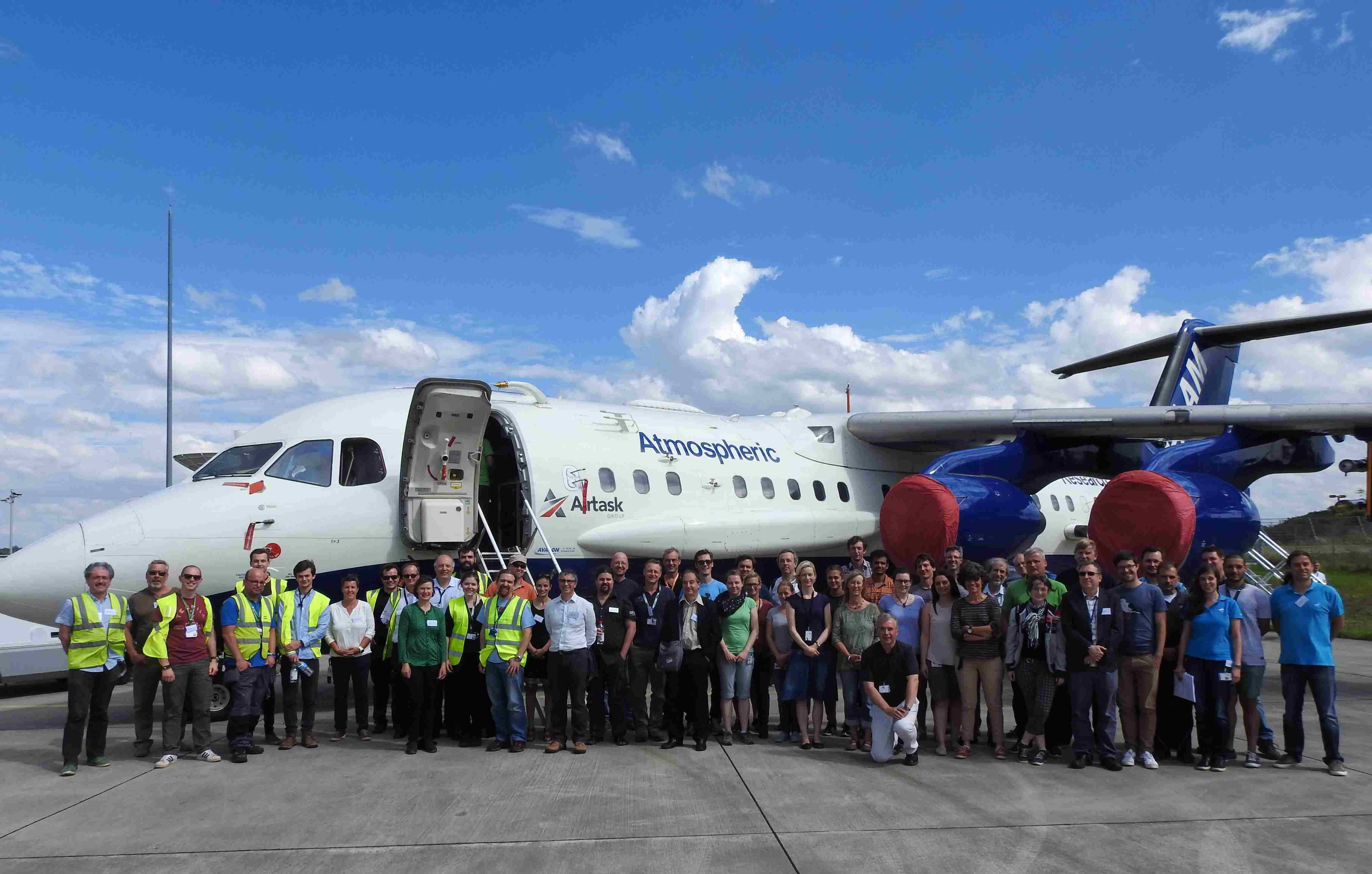EMeRGe
Effect of
Megacities on the Transport and Transformation of Pollutants on the
Regional to Global Scales
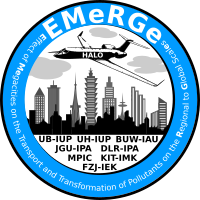
News
Last UK-NERC FAAM flight in the framework of EMeRGe international
Posted on 21 Jul 2017 by Lola
Our FAAM colleagues sent the report of their last flight within EMeRGe on the 20.07.2017.
FAAM observed very clean conditions in a strongly Westerly behind the front that had passed through and observed a plume with up to 20ppb NOx, ca. 30 miles wide and mostly confined to the bottom 250-300m of the BL due to clouds. Once the cloud had cleared the vertical structure of the plume was probed showing good correlation between black carbon and NOx.
We thank again all the FAAM team for these efforts and for their very valuable contribution to the scientific output of the EMeRGe project: It has been very nice to cooperate with you and we all are looking forward to analysing the data!
FAAM observed very clean conditions in a strongly Westerly behind the front that had passed through and observed a plume with up to 20ppb NOx, ca. 30 miles wide and mostly confined to the bottom 250-300m of the BL due to clouds. Once the cloud had cleared the vertical structure of the plume was probed showing good correlation between black carbon and NOx.
We thank again all the FAAM team for these efforts and for their very valuable contribution to the scientific output of the EMeRGe project: It has been very nice to cooperate with you and we all are looking forward to analysing the data!
Fourth EMeRGe mission flight in Europe (F#6)
Posted on 20 Jul 2017 by Wilke
A cut-off low developed over the British Islands and causes increasing precipitation and thunderstorm activity over Western and Central Europe.
From the EMeRGe target regions only Italy is still influenced by the high pressure ridge and therefore the eight and a half hours EMeRGe flight on 20.07.2017 focused on the investigation of the Po Valley and Rome outflows.
Most of the time HALO remained within the boundary layer and shuttles at ca. 1500ft, 3000ft and 8000ft were carried out downwind of the Po Valley, and upwind and downwind of Rome. On the way back HALO flew over the Alps at ca 27000 ft to probe uplifted air and the air over Munich was again probed before landing.
Again a very successful and interesting HALO flight. The Italian colleages measured black carbon and CO2 using a ultra light aircraft over the sites of San Pietro, Bologna and Monte Cimone just one hour later than HALO. We are looking forward to analysing the data!
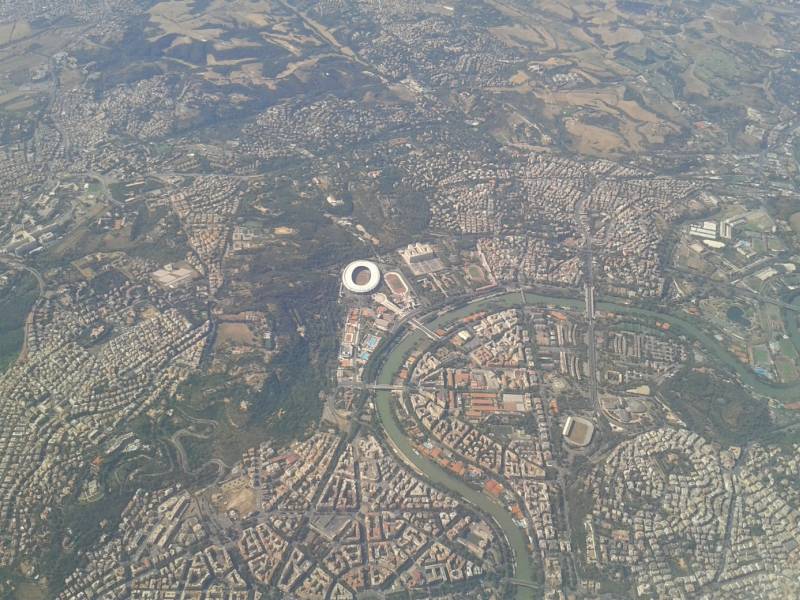
HALO overpass over Rome on 20.07.2017
From the EMeRGe target regions only Italy is still influenced by the high pressure ridge and therefore the eight and a half hours EMeRGe flight on 20.07.2017 focused on the investigation of the Po Valley and Rome outflows.
Most of the time HALO remained within the boundary layer and shuttles at ca. 1500ft, 3000ft and 8000ft were carried out downwind of the Po Valley, and upwind and downwind of Rome. On the way back HALO flew over the Alps at ca 27000 ft to probe uplifted air and the air over Munich was again probed before landing.
Again a very successful and interesting HALO flight. The Italian colleages measured black carbon and CO2 using a ultra light aircraft over the sites of San Pietro, Bologna and Monte Cimone just one hour later than HALO. We are looking forward to analysing the data!

HALO overpass over Rome on 20.07.2017
Third EMeRGe mission flight in Europe (F#5)
Posted on 17 Jul 2017 by Wilke
On 17.07.2017 the EMeRGe flight focused on the outflow of London and Paris.
HALO flight permission was constrained to the Channel Islands but it was also possible to fly in the afternoon over the close-by French airspace at altitudes 1500-2000ft for more than 4 hours after the initial low clouds vanished. The HALO flight #5 was combined with a plume tracer experiment released from the Imperial College in London in the evening before, ground based sampling of VOC, and two flights of FAAM in a circuit around London.
On the way back to Oberpfaffenhofen the outflow SW of Paris was investigated at 7000ft.
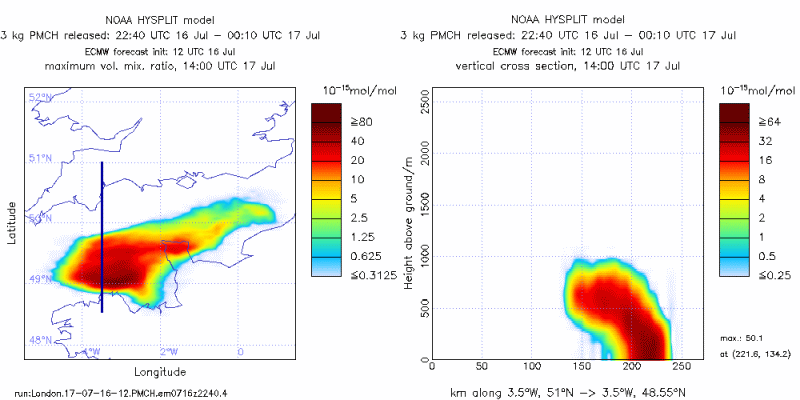
HYSPLITT simulation of the tracer dispersion plume at the overpass time of the HALO F#5.
HALO flight permission was constrained to the Channel Islands but it was also possible to fly in the afternoon over the close-by French airspace at altitudes 1500-2000ft for more than 4 hours after the initial low clouds vanished. The HALO flight #5 was combined with a plume tracer experiment released from the Imperial College in London in the evening before, ground based sampling of VOC, and two flights of FAAM in a circuit around London.
On the way back to Oberpfaffenhofen the outflow SW of Paris was investigated at 7000ft.

HYSPLITT simulation of the tracer dispersion plume at the overpass time of the HALO F#5.
Second EMeRGe mission flight in Europe (F#4)
Posted on 13 Jul 2017 by Wilke
The second EMeRGe mission flight took place on 13.07.2017 after the HALO-FAAM intercomparison between DLR HALO and FAAM-BAe 146.
HALO science teams made successful measurement over the pollution plumes for the urban areas in Sothern Germany and biomass burning. Both HALO and FAAM successfully measured in plumes which have been transported and transformed over longer distances.
Before the end of the flight the distribution of pollutants over Munich was additionally investigated.
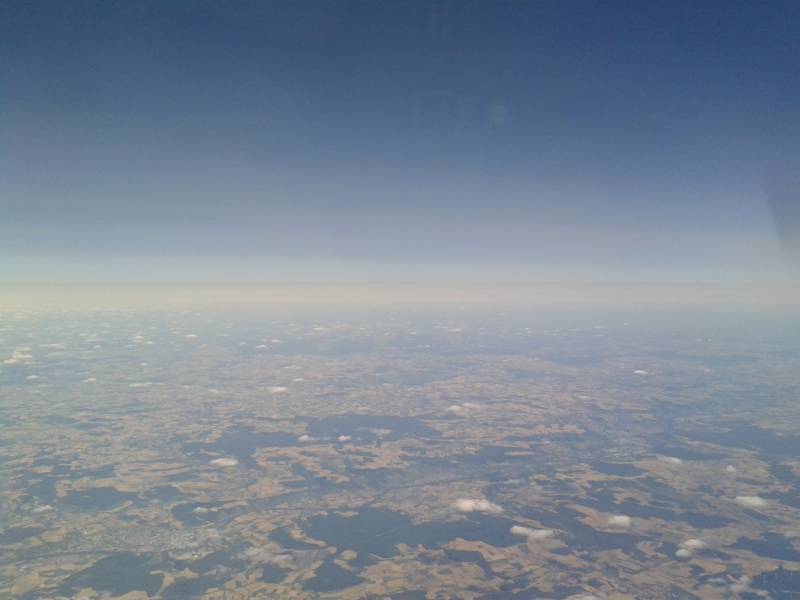
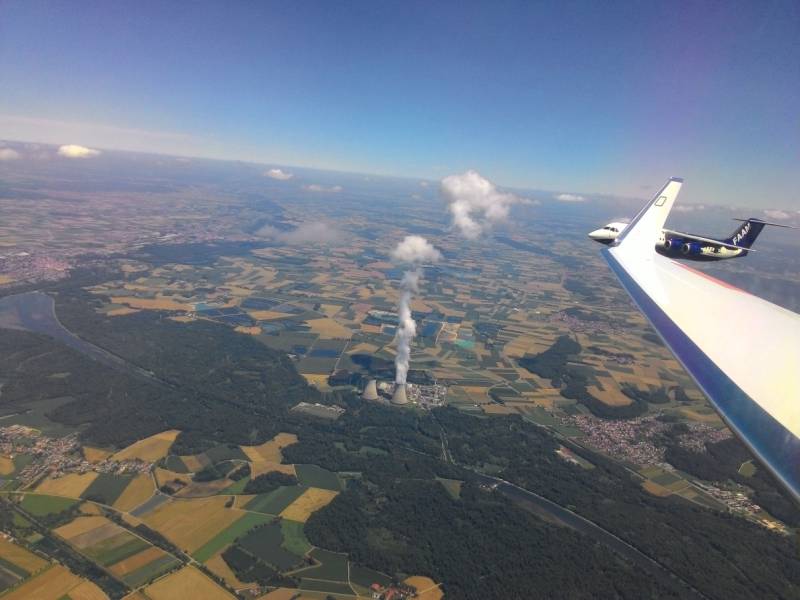
HALO science teams made successful measurement over the pollution plumes for the urban areas in Sothern Germany and biomass burning. Both HALO and FAAM successfully measured in plumes which have been transported and transformed over longer distances.
Before the end of the flight the distribution of pollutants over Munich was additionally investigated.


Intercomparison flights for instrumentation on DLR-HALO and UK-NERC-FAAM during the EMeRGe campaign in Europe
Posted on 13 Jul 2017 by Wilke
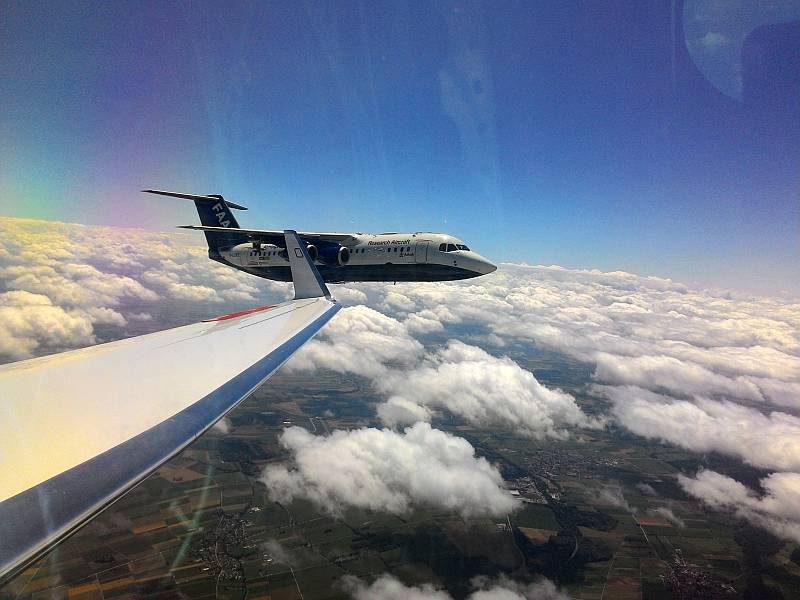
FAAM seen from HALO.
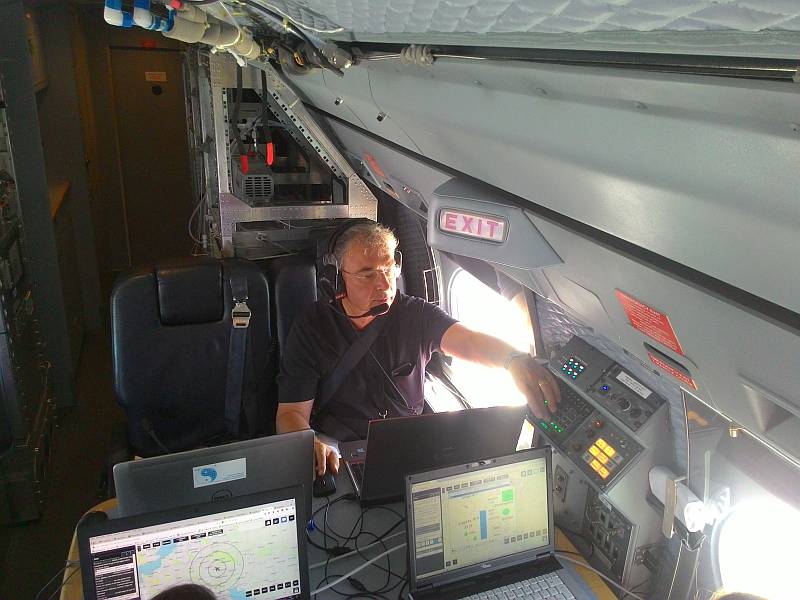
Prof. John Burrows was HALO's onboard mission PI.
As part of the EMeRGe campaign in Europe, the DLR HALO and UK NERC FAAM (BAe 146-301) aircraft are flying and make measurements of the transport and transformation of the emissions from mega cities and major population centres.
One key task was to undertake an inter-comparison of measurement being made by similar instruments on the two aircrafts. To achieve this goal 2017 the DLR HALO and UK NERC FAAM took off shortly after noon on 13.07.2017 from Oberpfaffenhofen and then flew to the Allgäu region. The mission PI on board the HALO was Prof. John Burrows from the University of Bremen.
The intercomparison exercise comprised measurements, made at three altitudes (~5km (15000ft), ~3 km (1000ft) 1.2km (4000ft)) in a race track pattern over approximately 2 hours. The two aircraft made a series close formation wing to wing set of flights and measurements. Such flying patterns require great skill by the pilots of the two aircraft. It enables identical air mass to be probed by the research instrumentation. This in turn yields a validation of the calibrations and measurements of these instruments and science data.
After the inter-comparison exercise, the two aircraft flew northward sampling air over southern Germany. FAAM Bae 146-301 then flew back to its base in Cranfield making measurements in North Germany, the Netherlands and the south east of the UK. The DLR-HALO made a series of transects over southern Germany at different altitudes. This was then followed by a sortie over Munich, aimed to investigate its emissions, prior to landing at Oberpfaffenhofen. Pollution from the major populations centres and long range transport from biomass burning and anthropogenic pollution from North America was observed.
First EMeRGe mission flight in Europe (F#3)
Posted on 12 Jul 2017 by Lola
On 11.07.2017 the first HALO mission flight within EMeRGe was carried out from 10 to 16:30 UTC.
A main focus was the investigation of the Po Valley and Rome outflows in Italy.
The information about these EMeRGe scientific targets gathered by the HALO-EMeRGe instrumentation has been enhanced by the instrumented CNR- Sky Arrow ERA aircraft flying over Rome and by other measurements of the LIDAR and Ground Based network within EMeRGe international.
A main focus was the investigation of the Po Valley and Rome outflows in Italy.
The information about these EMeRGe scientific targets gathered by the HALO-EMeRGe instrumentation has been enhanced by the instrumented CNR- Sky Arrow ERA aircraft flying over Rome and by other measurements of the LIDAR and Ground Based network within EMeRGe international.
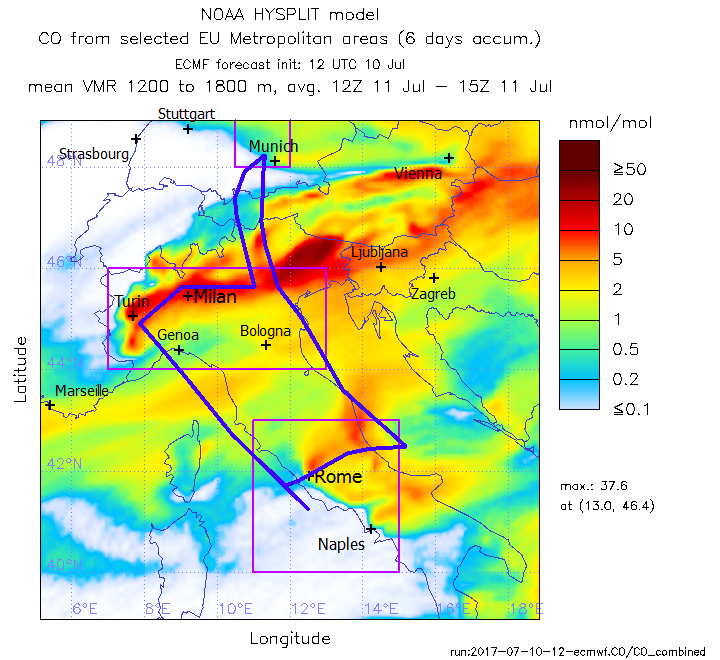
|
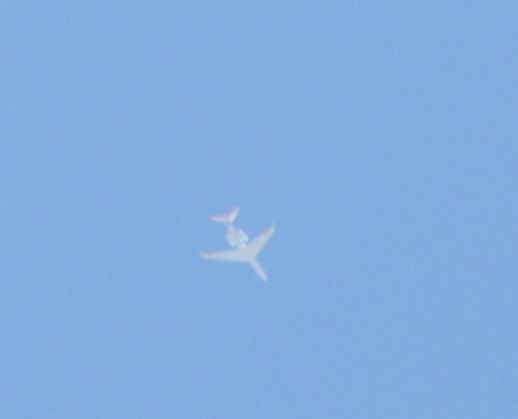 HALO photographed from the roof of the University Rome I as passing over Rome at 13:22 UTC. |
Mission modification approved
Posted on 07 Jul 2017 by Wilke
DLR-FX communicated today that the certification of the mission modification has been approved and HALO is on schedule ready for the official mission start on Monday July 10.
These are excellent news and we thank DLR-FX, Enviscope/Gomolzig and all the scientists, engineers and administrators, who have enabled us to pass this milestone successfully.
We are also indebted to our EMeRGe international partners some of whom have already made some valuable measurements for EMeRGe.
We are also indebted to our EMeRGe international partners some of whom have already made some valuable measurements for EMeRGe.
